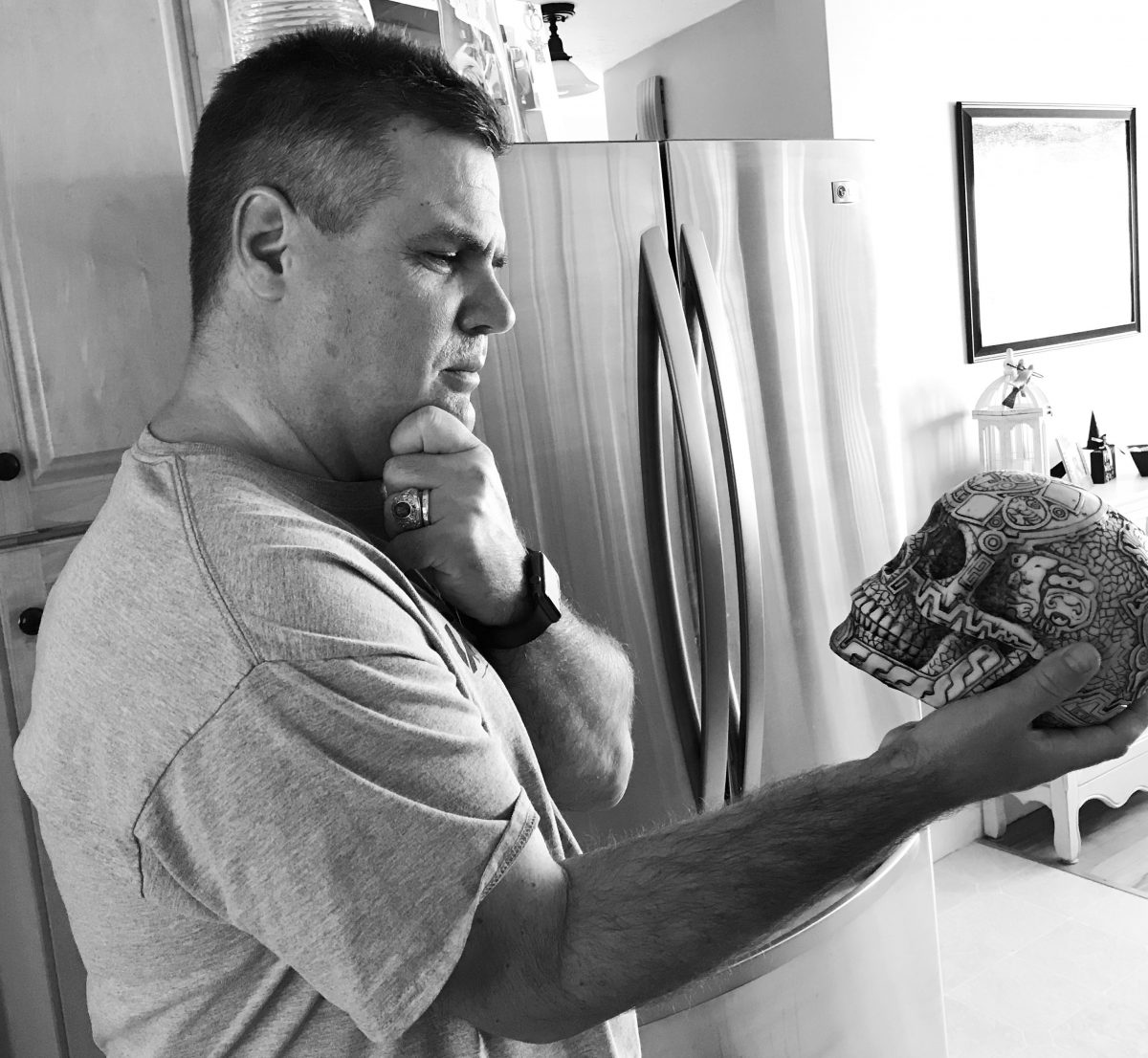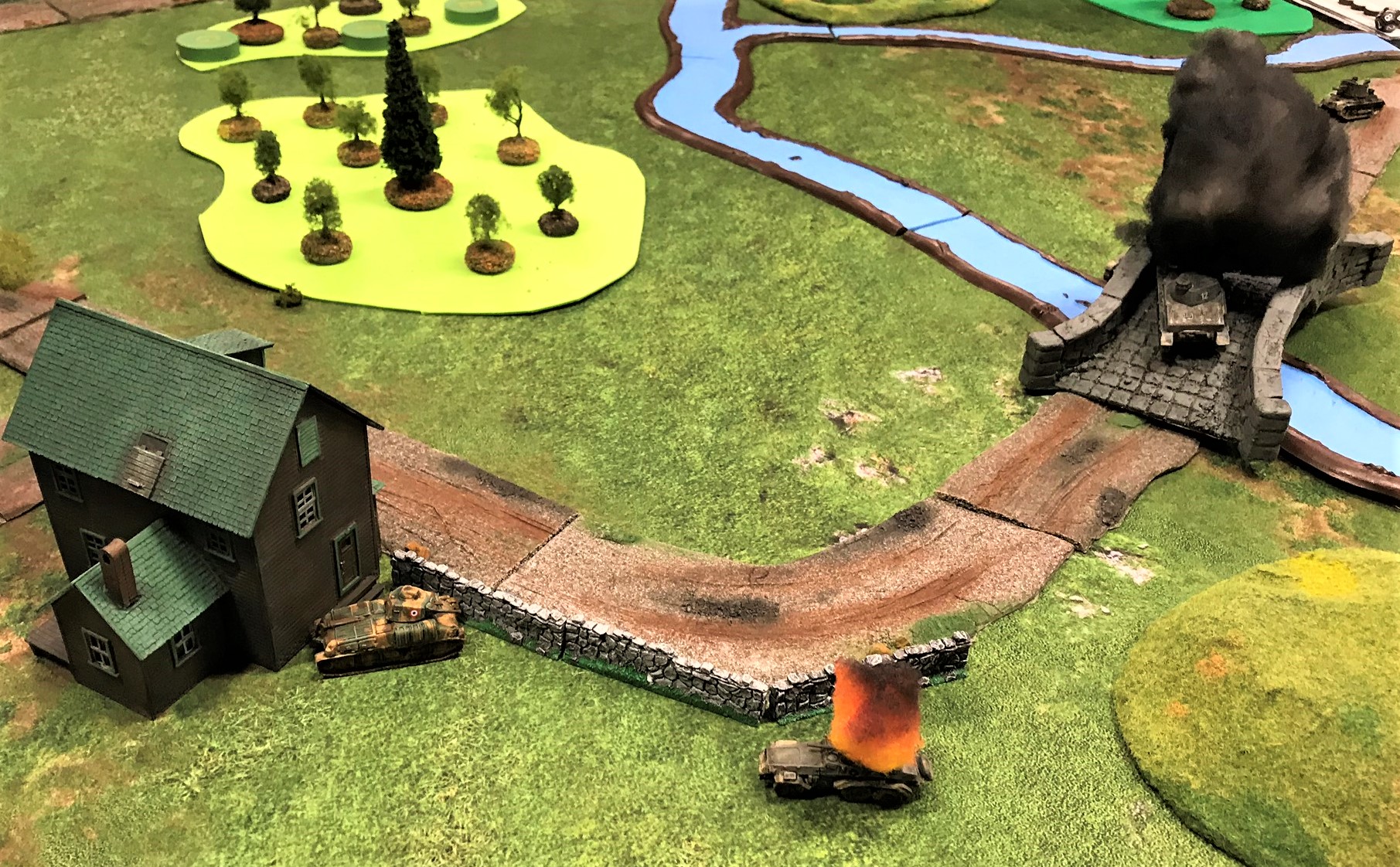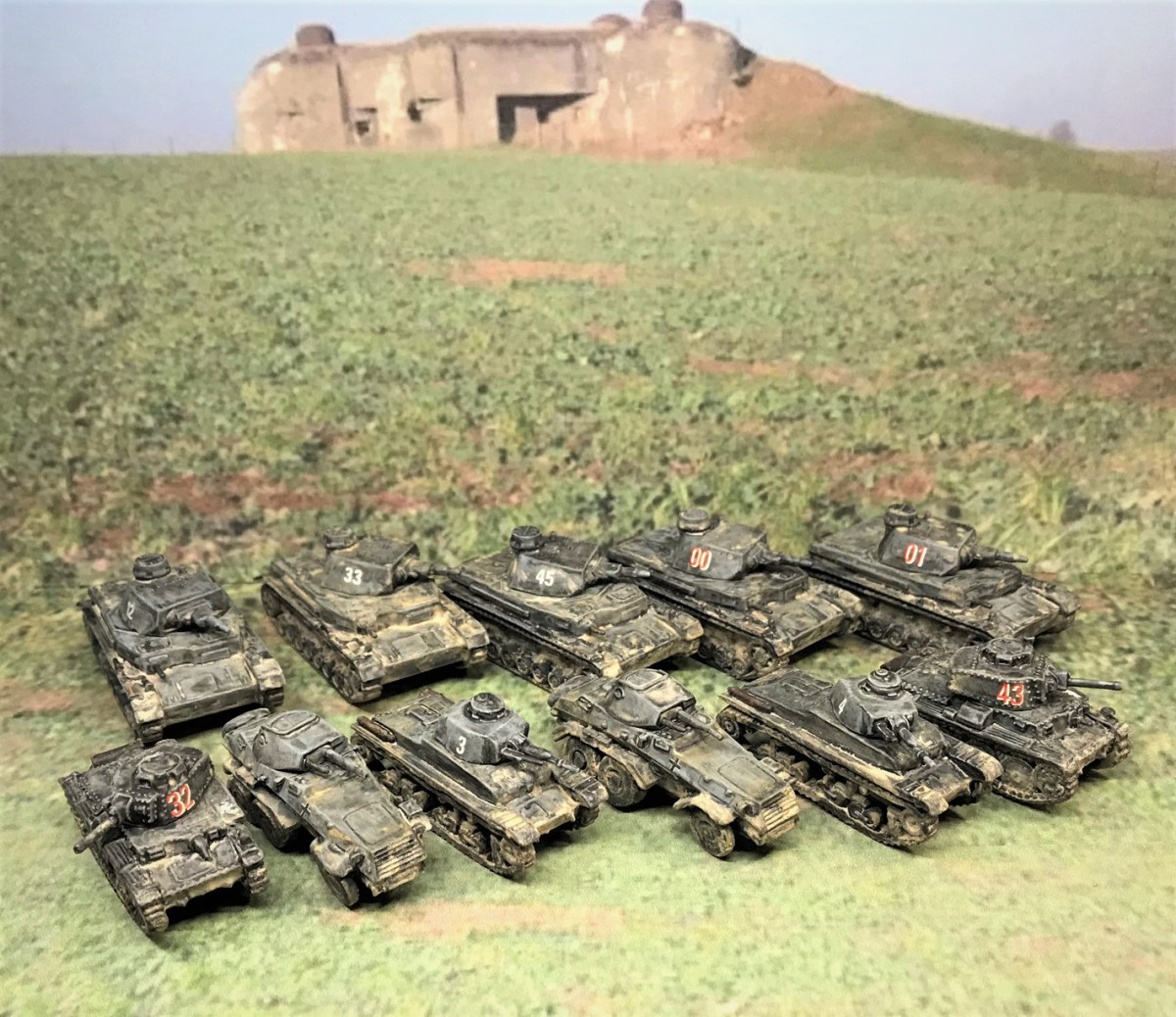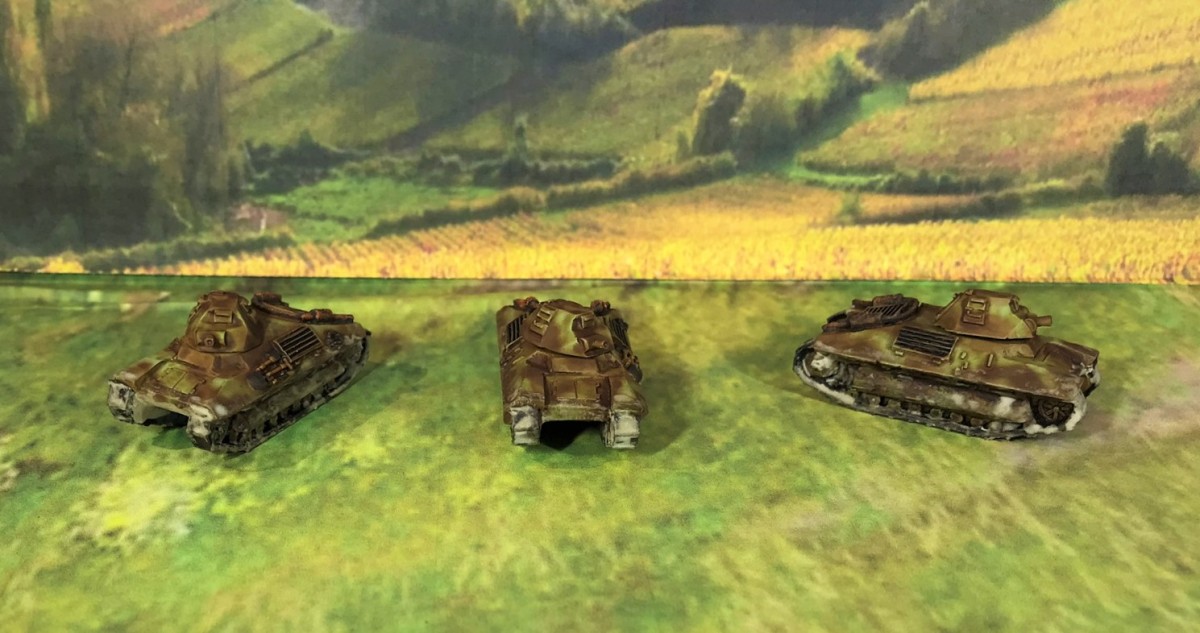This post covers the second game that I ran at TotalCon 36 in Marlboro, Massachusetts on the morning of Friday, February 25th. The scenario has the Germans are coming out of a wooded area and trying to break out through the French lines to the other side of the tabletop, and ostensibly on to the sea. The French of course must attempt to stop them.

I used the Too Fat Lardies What a Tanker Rule set with some modifications. The French set up secretly at any of 18 possible hidden locations (and letting me, the GM, know so that I can adjudicate issues without compromising the French deployment locations). The French tanks remain so hidden until they are spotted or if they choose to shoot their main guns or move.
The Germans deploy onto the tabletop on one of two roads that cross bridges over a river (treated as a minor or major obstacle depending upon where a crossing is attempted). The bridges may or may not be already successfully wired for demolition. As the GM, I resolve that secretly to add more “fog of war ” as a) the Germans may not detect if the bridges were wired properly or at all and correspondingly b) the French sapeurs (combat engineers) may or may not have wired the bridges correctly for successful demolition. The French also get one small minefield (3″ x 5″) that is rarely effective due to the What a Tanker rules. Also, the French use of mines was nearly nonexistent in 1940, mainly because of logistics. However, that small minefield is available there and that is also deployed secretly at the start of the game by the French. The picture below is my set up guide:

One change that I made from my previous iterations of this scenario was to eliminate the use of poker chips for scoring and resource acquisition. I made “Tanker Bucks” instead. I had found that the poker chips’ values were not always easily understood (as not everyone hits the casino). I also had an excessive number of differently-colored file folders left over from various jobs that I had had before my retirement. I cut up the folders into same-sized an same-colored 3″ x 5″card stock using my paper cutter. I designed the Tanker Bucks in PowerPoint, using images of my 1940 vehicle models – and printed them off on the card stock on two sides with the same images:

These Tanker Bucks serve three purposes. First, score is kept with the “Tanker Bucks” – as the side with the most Tanker Bucks at the end of the game wins. Second, Tanker Bucks are earned by each side for achieving objectives. Third, they are used to buy resources such as new or respawning tanks, as well as Bonus Attack Cards (BAC’s).
Tanker Bucks are earned by a side by:
- Knocking out an enemy tank or armored car earns Tanker Bucks (getting a 20% bonus over the initial cost of the AFV).
- Reconnoitering one of the secret French deployment locations(by the Germans) or voluntarily uncovering one (by the French) both earn Tanker Bucks.
- Successfully crossing the board to the other side earns the Germans a 20% bonus.
- Gaining objective bonuses (French only). The French earn potential bonuses at the game’s end in two ways. First. and most importantly, by preventing the Germans from crossing the tabletop. That earns them $25 if none cross, $10 if only 1 crosses, and $0 if more than 2 vehicles cross. Second, they get points for any initial deployment points that have not been uncovered or reconnoitered.
Tanker Bucks are assigned to the team captain, but team collaboration in their use is expected. Each side starts with 100 Tanker Bucks per side or 30 per player, whatever is bigger. Both sides must start with recon vehicles (two SdKfz 231 6 rad for the Germans and three Panhard 178’s for the French. They each may also start with one additional light tank, and they must pay for them all out of their initial Tanker Bucks.
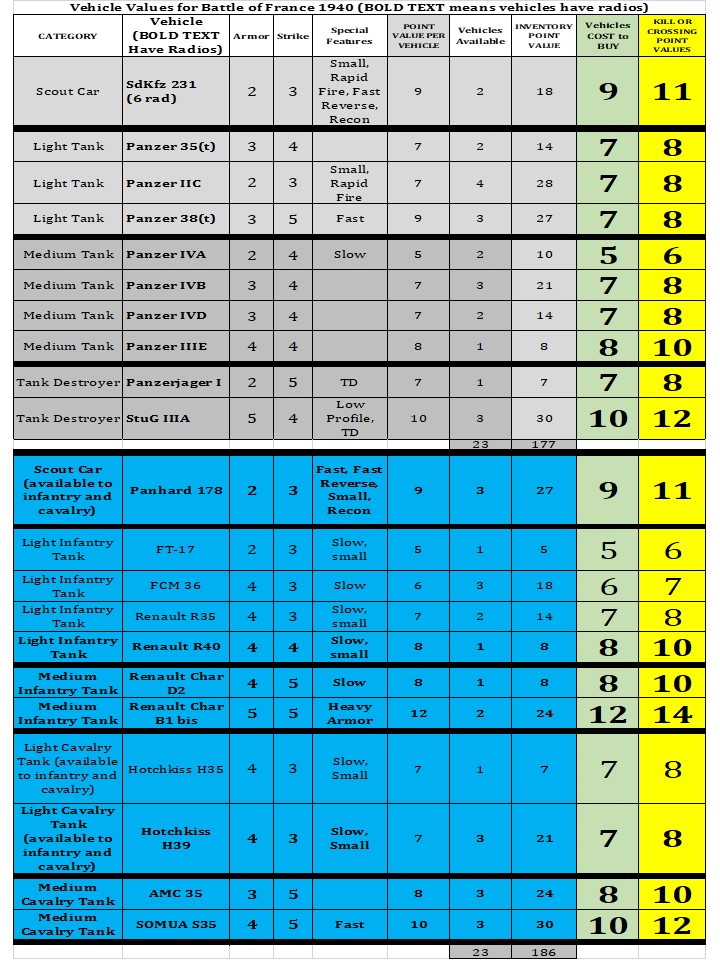
Tanker Bucks are used to:
- Buy new AFV’s or upgrade respawning vehicles. Respawning vehicles are replacements for ones that have been either knocked out or that have made it across the tabletop. If the replacement vehicle is of lesser value, there is a refund of the value difference. If the replacement vehicle is of greater value, there is an upcharge of the value difference.
- Buy Bonus Attack Cards (BAC’s).
- BAC’s bring the combat effects of other arms or additional resources to a vehicle – at a cost of $5 per card.
- Buying them is a risk/reward proposition there are no guarantees what card will be bought. The Germans get a chance at a card giving them air support for example, while the French have no chance at that. Similarly, each card bought gives the French relatively more chances for infantry, anti-tank gun, or artillery support.
- Each recon vehicle can buy and have two BAC’s, and each tank with a radio can have one. These radios replicate the German historical communications advantage as many of the French vehicles have no radios and cannot buy BAC’s. The BAC’s cost $5 each, and are different for each side (see below).
Bonus Attack Cards are additional combat and logistical resource opportunities that can be bought as described below.

On to the Game! I am only mostly sure as to the end score for the turns here – so this is my best recollection of the action. I wish I had more photos, and my thanks to Mal for some of these.

Turn 1
The French team (Mal, John, and Cameron) decided to not buy any tanks in addition to the three mandatory Panhard-178’s. They bought two BAC’s for each scout car. The German team (Steven and Leif -and later joined by Gregg) bought the two mandatory SdKfz 231 (6-rad)’s, plus a Panzer 35(t). They also got 5 BAC’s to distribute among them. All deployed onto the tabletop and a few BAC’s came into play as the hidden Panhards called in a few French infantry attacks that failed to hurt the Germans. Meanwhile, the Germans did some reconnaissance, searching for the French. The end of the turn found the Germans ahead, 54-47.
Turn 2
The Germans conserved their Tanker Bucks and spent the turn looking for an enemy to shoot. The French decided to get an R40 tank (Mal) and a BAC, as well as replenish their BAC’s used in the previous turn. No additional Tanker Bucks were gained for the Germans who tried in vain to find a French target – and barely failing to find Cameron’s Panhard in the woods. Notably, the Germans avoided either bridge, choosing instead to ford the river. Cameron, seeing how close one of the German SdKfz 231 (6-rad)’s was to his Panhard, activated it and slightly damaged it before getting further into woods where it was safer. With the French purchases, the end of the turn found the Germans further ahead, 54-32.
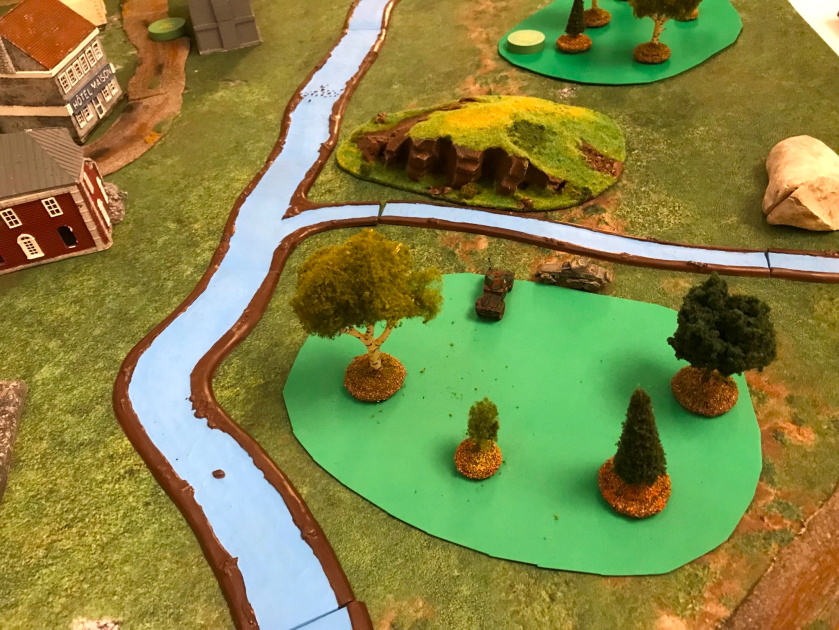
Turn 3
The Germans decided that given their lead, they could safely use their Tanker Bucks to jump to the next category and get a Panzer IVD for Leif, bringing them to 4 vehicles on the table. They did not buy any more BAC. The French were feeling poor, so they bought no vehicles or BAC. The French did uncover all of their vehicles during the turn to get a few more bucks and to move and shoot as well as to use BAC. They also attempted to blow the bridge under the Panzer IVD, but the wires fizzled. The Panhards did call in artillery fire that did cause some damage to the Panzer IVD. Additionally, from a hidden location, John’s Panhard opened fire on Leif’s SdKfz 231 (6-rad) and set it ablaze. On the German left, the French R40 took out Steven’s Panzer 35(t) with a side shot. The Germans were able to do more reconnaissance – enough to cover the cost of new – and now-damaged Panzer IVD. The end of the turn found the French catching up but the Germans still ahead, 58-44.

Turn 4
Both sides dug into their Tanker Bucks wallets this time. Cameron bought a Char B1 bis (pricey at $12) and a BAC and deployed this tank secretly in a covered position. The Germans respawned Steven’s lost Panzer 35(t) with a StuG IIIA plus a BAC. Leif bought a new Panzer IIC. Mal’s R40 called in smoke to cover his R40 from the approaching StuG IIIA. The Germans reconned more vacant French positions. The purchases on both sides found the Germans slightly increasing their lead to 51-27.


Turn 5
The French went on an austerity budget, only buying a replacement BAC. The Germans got a new player, Gregg, to take over the Panzer IIC, and they also went a bit on a spending spree to buy a studly Panzer IIIE for him and 2 BAC. The French made progress! The previously-damaged Panzer IVD got taken out by the Char B1 bis, and Steven’s remaining SdKfz 231 (6-rad) got taken out by artillery. The Germans called in Stukas to hit the Char B1 bis, but missed. The Panzer IIC ran nearly the length of the table but did not get off the table. The French successes saw the score reversed to 41-28 in favor of the French.
Turn 6
Hoping to maintain their lead, the French spent nothing. The Germans respawned Steven’s scout car with a Panzer 38(t), and Leif’s Panzer IVD with a Panzerjager I. They also bought a Panzer IVB for Gregg. The Panzer IIC (Gregg) activated and crossed the rest of the tabletop, cutting into the French’s endgame bonus opportunity. Steven’s Panzer 38(t) with a magical roll of the dice hightailed it across the other bridge and neared the other side. At the same time another French demolition attempt fizzled, and the hidden minefield caused no damage to the Germans. Meanwhile, Steven’s StuG IIIA hunted down Mal’s R40 (which was trying desperately to stop Steven’s Panzer 38(t)). The R40 was destroyed by the StuG by devastating shots to the French vehicle’s rear armor. The French successes of the previous turn were vaporized. The Germans’ successes saw the score reversed to 52-41 in their favor.

Turn 7
Neither side bought anything on this Turn. The Panzer 38(t) easily crossed the tabletop before the French could stop it, as did the Panzer IIIE. This effectively nullified the French endgame bonus. No further losses happened on the German side, but the French lost a few of their remaining vehicles (not completely sure which ones) as they desperately tried to kill anything German. The French got bonus points for uncovered deployment positions, but it was not enough and after applying bonuses the Germans had won 100-70.

I want to thank the players – who all said they had a good time. I will keep this scenario in my quiver – it is a lot of fun, though I will do a few minor tweaks on it. I also want to thank Leif for his help, as well as Bryan Clauss!
I also offered a prize for the game – a 1000-piece tank jigsaw puzzle, won by Leif in a roll-off.

This was my second game of the con – my first can be found here for those interested.
